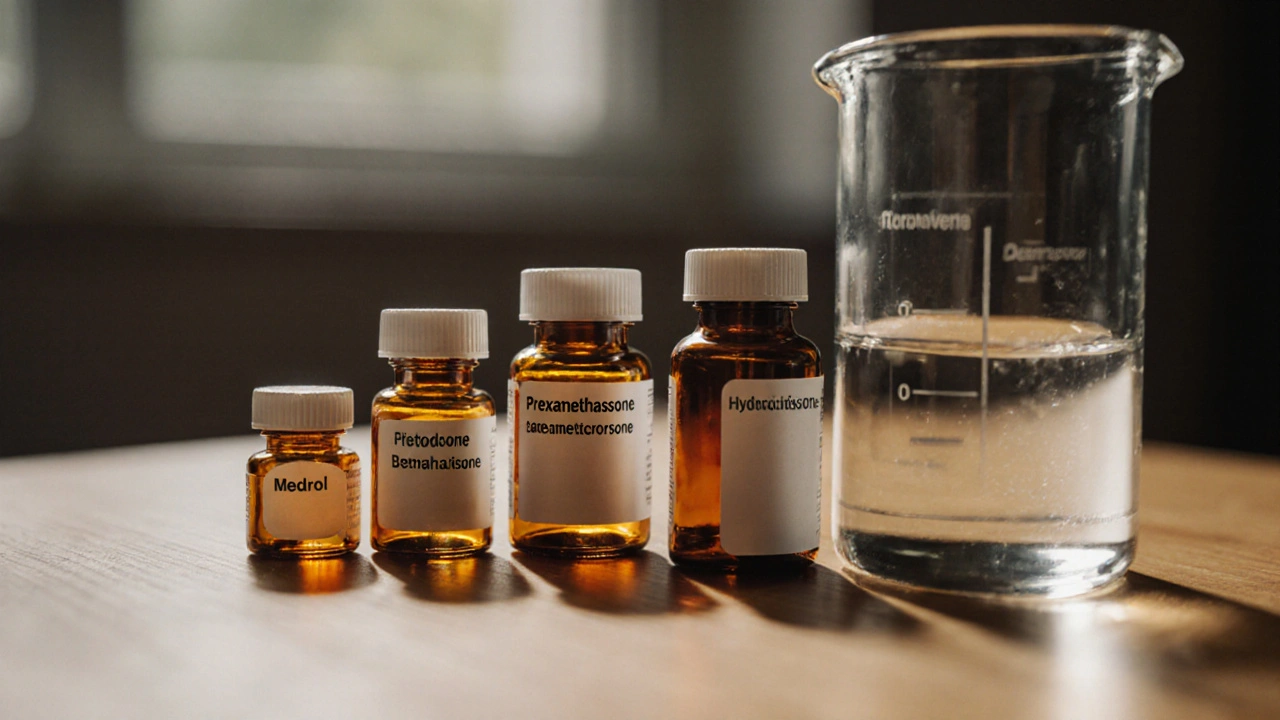Steroid Selector: Find Your Best Corticosteroid Match
Select Your Condition
Your Priority Factors
Recommended Steroid
Comparison Table
| Generic Name | Potency (vs Hydrocortisone) | Onset Time | Half-Life | Best For |
|---|
You've probably seen the name Medrol on a prescription label and wondered if there's a better fit for your condition. With dozens of corticosteroids on the market, choosing the right one can feel overwhelming. This guide breaks down Medrol, lines it up against the most common alternatives, and helps you decide which steroid matches your health needs.
Key Takeaways
- Medrol (methylprednisolone) sits in the middle of the potency ladder-stronger than hydrocortisone but milder than dexamethasone.
- For short‑term flare‑ups, prednisone and dexamethasone act faster but may carry higher risk of mood swings.
- Long‑acting steroids like betamethasone are useful for skin conditions but can suppress the adrenal axis more profoundly.
- Side‑effect profiles overlap, yet dosing frequency and half‑life create practical differences in daily life.
- Never switch steroids on your own; tapering schedules are essential to avoid withdrawal.
What Is Medrol?
When your doctor prescribes Medrol (methylprednisolone), they’re giving you a synthetic corticosteroid that mimics the body's natural hormone cortisol. Its primary job is to calm inflammation and dial down an overactive immune response.
Typical uses include:
- Acute asthma attacks
- Rheumatoid arthritis flare‑ups
- Severe allergic reactions
- Dermatitis and eczema exacerbations
Medrol is usually taken orally in tablet form, with doses ranging from 4mg (low‑dose) to 48mg (high‑dose) depending on severity. Its half‑life sits around 18-36hours, meaning you often need a once‑or‑twice‑daily schedule.
How Corticosteroids Differ
All corticosteroids share a core mechanism-binding to glucocorticoid receptors-but they vary in three key ways:
- Potency: How strong the anti‑inflammatory effect is relative to hydrocortisone (the reference standard).
- Duration of action: Short‑acting agents clear quickly, while long‑acting ones linger for days.
- Pharmacokinetics: Onset speed, half‑life, and preferred route (oral, IV, topical).
Understanding these dimensions lets you line up Medrol against its peers and see where each shines.

Side‑by‑Side Comparison of Common Steroids
| Generic | Brand (example) | Relative Potency* (vs Hydrocortisone) | Typical Oral Dose | Onset (hrs) | Half‑Life | Common Indications | Key Side‑Effect Notes |
|---|---|---|---|---|---|---|---|
| Methylprednisolone | Medrol | 5‑8 | 4‑48mg daily | 1-2 | 18-36hrs | Asthma, arthritis, severe allergies | Moderate fluid retention; mood changes less common than with dexamethasone |
| Prednisone | Deltasone | 4‑5 | 5‑60mg daily | 1-2 | 12-36hrs | Respiratory diseases, autoimmune disorders | Higher chance of insomnia and glucose spikes |
| Dexamethasone | Decadron | 25‑30 | 0.5‑9mg daily | 0.5-1 | 36-54hrs | Brain edema, severe allergy, chemotherapy‑induced nausea | Strong anti‑emetic effect; higher risk of mood swings, insomnia |
| Hydrocortisone | Cortef | 1 (reference) | 20‑240mg daily | 1-2 | 8-12hrs | Adrenal insufficiency, replacement therapy | Least potent; usually needs multiple daily doses |
| Betamethasone | Celestone | 30‑35 | 0.5‑3mg daily (oral) or topical strength | 1-2 | 36-72hrs | Severe skin disorders, osteoarthritis, lung disease | Long‑acting; higher risk of bone loss on prolonged use |
| Triamcinolone | Kenalog | 5‑10 | 4‑16mg daily | 1-2 | 12-36hrs | Dermatitis, asthma, allergic rhinitis | Often used as injectable; local tissue atrophy possible |
*Potency is expressed as a multiple of hydrocortisone’s anti‑inflammatory strength. Higher numbers mean a smaller dose achieves the same effect.
Choosing the Right Steroid for Common Conditions
Below is a quick match‑up that pairs typical diagnoses with the steroid that generally offers the best balance of speed, potency, and side‑effect tolerance.
- Acute asthma attacks: Dexamethasone works fastest, but if you need a smoother taper, Medrol or prednisone are preferred.
- Rheumatoid arthritis flare‑ups: Medrol’s mid‑potency and convenient dosing make it a go‑to; betamethasone may be reserved for severe, refractory cases.
- Severe skin conditions (psoriasis, eczema): Topical betamethasone or triamcinolone provide high local potency with minimal systemic exposure.
- Systemic lupus erythematosus: Prednisone is traditionally used because its dosing flexibility matches the disease’s fluctuating nature.
- Adrenal insufficiency (replacement therapy): Hydrocortisone, not Medrol, is the standard because it mimics the body’s natural cortisol curve.
Remember, the “best” steroid isn’t universal-it hinges on how quickly you need relief, how long you plan to stay on the drug, and your personal risk profile (diabetes, osteoporosis, psychiatric history, etc.).
Side‑Effect Landscape: What Sets Medrol Apart?
All corticosteroids can cause:
- Increased blood sugar
- Fluid retention and elevated blood pressure
- Weight gain and facial rounding ("moon face")
- Suppressed immune response, raising infection risk
- Bone loss with long‑term use
Where Medrol diverges is in the balance of potency versus duration. Because it’s not ultra‑potent, the spike in blood sugar tends to be milder than with dexamethasone, yet you still avoid the multiple daily dosing of hydrocortisone. Patients often report fewer sleep disturbances compared with high‑dose dexamethasone, making Medrol a reasonable middle ground for people who need steady control without the jittery side‑effects of the most powerful steroids.
Practical tips to blunt side effects regardless of the drug you pick:
- Take the medication with food to lessen stomach irritation.
- Monitor blood glucose if you have diabetes; a short‑term increase is common.
- Stay hydrated and limit sodium to counter fluid retention.
- Ask your doctor about calcium and vitamin D supplements if therapy extends beyond two weeks.
- Never stop a steroid abruptly-follow a taper schedule to let your adrenal glands recover.

Switching or Tapering: A Safe Playbook
If you’ve been on one steroid and your doctor suggests an alternative, the transition must respect the drug’s half‑life and potency. Here’s a simple rule‑of‑thumb:
- Calculate the total daily glucocorticoid dose in hydrocortisone equivalents (e.g., 4mg Medrol ≈ 20mg hydrocortisone).
- Match that equivalent to the new drug’s potency chart.
- Start the new steroid at the calculated equivalent dose, then taper the old drug over 3‑5 days to avoid overlap.
Example: Switching from 12mg Medrol (≈60mg hydrocortisone) to dexamethasone (potency ≈30) would mean an initial dose of about 2mg dexamethasone, then slowly reduce Medrol.
Always involve your prescriber; abrupt changes can trigger adrenal crisis, a potentially life‑threatening condition.
Bottom Line: How to Pick the Right Steroid
Ask yourself these three questions before signing a prescription:
- Speed of relief: Do I need a drug that works within an hour (dexamethasone) or can I wait a day (hydrocortisone)?
- Duration of therapy: Is this a short burst (a few days) or a chronic regimen (weeks to months)?
- Personal risk factors: Do I have diabetes, osteoporosis, or a history of mood disorders that would steer me away from high‑potency steroids?
If you favor moderate potency, once‑or‑twice‑daily dosing, and a decent safety margin, Medrol often hits the sweet spot. For ultra‑rapid or ultra‑potent needs, dexamethasone or betamethasone may be better, but they demand tighter monitoring.
Frequently Asked Questions
What makes Medrol different from prednisone?
Medrol (methylprednisolone) is slightly more potent than prednisone, meaning you need a lower milligram dose for the same anti‑inflammatory effect. It also has a longer half‑life, which often allows twice‑daily dosing instead of the three‑times‑daily schedule sometimes required for prednisone.
Can I use Medrol for skin conditions?
Oral Medrol can help severe eczema or psoriasis when topical steroids aren’t enough, but dermatologists usually prefer high‑potency topical agents like betamethasone to avoid systemic side effects.
Is it safe to take Medrol during pregnancy?
Low‑to‑moderate doses of corticosteroids are generally considered safe in pregnancy when benefits outweigh risks. Always discuss dosage and timing with your obstetrician before starting any steroid.
How do I taper off Medrol after a short course?
For a 5‑day course, most doctors recommend dropping the dose by 20‑25% every 2‑3 days until you reach a physiologic equivalent of hydrocortisone, then stop. Your physician will tailor the schedule based on duration and total dose.
What should I monitor while on Medrol?
Watch blood pressure, blood glucose, weight, and mood changes. Schedule a follow‑up blood test for electrolytes if you’re on the drug more than two weeks.


10 Comments
Wow-this deep‑dive into corticosteroids feels like navigating a jungle of chemistry, dosage charts, and side‑effect warnings, all while trying to keep your sanity intact! First, let’s acknowledge that Medrol sits smugly in the middle of the potency ladder, a perfect example of “just right” when you need something stronger than hydrocortisone but not as aggressive as dexamethasone. The half‑life of 18–36 hours means you can usually get away with once‑or‑twice‑daily dosing-no more frantic pill‑popping at dawn and dusk! It’s also worth noting that the onset of 1–2 hours is fast enough for acute flare‑ups, yet slow enough to avoid the jittery insomnia that often haunts dexamethasone users.
When you compare Medrol to prednisone, you’ll notice that methylprednisolone is slightly more potent, so you need a lower milligram dose for the same anti‑inflammatory punch-an economy of scale that patients love. On the flip side, dexamethasone’s potency (25–30× hydrocortisone) makes it the go‑to for emergencies like brain edema, but that power comes with a side‑effect bouquet of mood swings, insomnia, and glucose spikes.
Hydrocortisone, the humble reference point, is the least potent and requires multiple daily doses, making it a poor choice for anything beyond adrenal replacement therapy. Meanwhile, betamethasone’s long‑acting nature (half‑life up to 72 hours) can be a boon for severe skin disorders, yet it flirts dangerously with bone loss when used for weeks on end.
Triamcinolone, often injected, brings local tissue atrophy into the conversation-something you don’t want when treating delicate facial lesions.
Side‑effects across the board include fluid retention, elevated blood pressure, and the ever‑looming threat of osteoporosis with long‑term use, but Medrol tends to sit in the sweet spot of moderate fluid retention and fewer mood disturbances.
Practical tips: always take your steroid with food, monitor blood glucose if you have diabetes, stay hydrated, and consider calcium/vitamin D supplements for bone health. And-never, ever stop a steroid cold; tapering is essential to avoid adrenal crisis.
In short, Medrol is the reliable middle‑child of the steroid family-strong enough to tame inflammation, gentle enough to keep side‑effects manageable, and flexible enough for a variety of conditions from asthma to rheumatoid arthritis. Choose wisely, and let your doctor guide the taper.
Honestly, the way this guide lines up Medrol against its steroid cousins is a masterclass in clarity; the tables are crisp, the potencies are spot‑on, and the practical advice feels like it was written by someone who’s actually prescribed these meds, not just scraped Wikipedia. I appreciate the balanced tone-no hype, just facts, which is rare in health forums where everyone tries to sound like a guru. The section on tapering is especially valuable; too many patients think they can just stop after a few days and end up in adrenal shock. The only tweak I’d suggest is a quick note on how insurance formularies sometimes force a switch from Medrol to prednisone, which can subtly affect blood sugar control. Overall, solid work, kudos to the author.
👍 Great rundown! I’ve been on a short Medrol burst for an asthma flare and the quick relief was a lifesaver. The tip about taking it with food helped me avoid stomach upset, and the reminder to watch blood sugar is spot‑on for my type‑2 diabetes. 🍎💊 Also, the taper schedule they mentioned saved me from that dreaded “feel‑off” when I tried quitting cold. Thanks for the clear guide!
Reading through the long comment, I’m reminded how important it is to keep perspective-no single steroid is a silver bullet. Each has its niche, and the best choice often depends on personal health history and the specific condition. While Medrol is a reliable all‑rounder, some patients may truly benefit from the ultra‑potent, fast‑acting dexamethasone in emergencies, provided they’re monitored closely. It’s all about matching the drug’s pharmacokinetics to the clinical scenario, and this guide does a great job of laying that out without bias.
Medrol works fine for most cases.
While the information presented appears thorough, one cannot ignore the underlying agenda driving the promotion of certain corticosteroids over others; pharmaceutical conglomerates have a vested interest in steering both prescribers and patients toward brand‑name formulations that maximize profit margins. It is imperative to scrutinize the source of funding for such guides, as undisclosed sponsorships may bias the ostensibly neutral comparisons, subtly influencing clinical decisions in favor of high‑revenue drugs.
Sure, the guide is clear, but remember that some of the “best” options may not be covered by all insurance plans, so you might end up paying more out of pocket.
Honestly, if you’re looking for a quick fix, dexamethasone is the king of speed-but don’t be surprised when the side‑effects come roaring in like a bad movie sequel. It’s powerful, yes, but the mood swings and insomnia can make you feel like you’re living in a nightmare. For most day‑to‑day flare‑ups, Medrol is the smarter, steadier choice, especially if you care about keeping your blood sugar stable. Nothing beats a balanced approach.
Stop glorifying steroids; they’re a double‑edged sword that can ruin lives if mishandled. The guide glosses over the serious risks, and anyone reading this needs a reality check-don’t think a short article makes them safe.
From a cultural perspective, it is essential to acknowledge that patient education on corticosteroid use varies globally, and resources such as this guide play a pivotal role in bridging knowledge gaps. The thorough explanations, especially regarding tapering protocols and side‑effect monitoring, are commendable and will undoubtedly aid both clinicians and patients in making informed decisions. I encourage further dissemination of such balanced content across multilingual platforms.
Write a comment